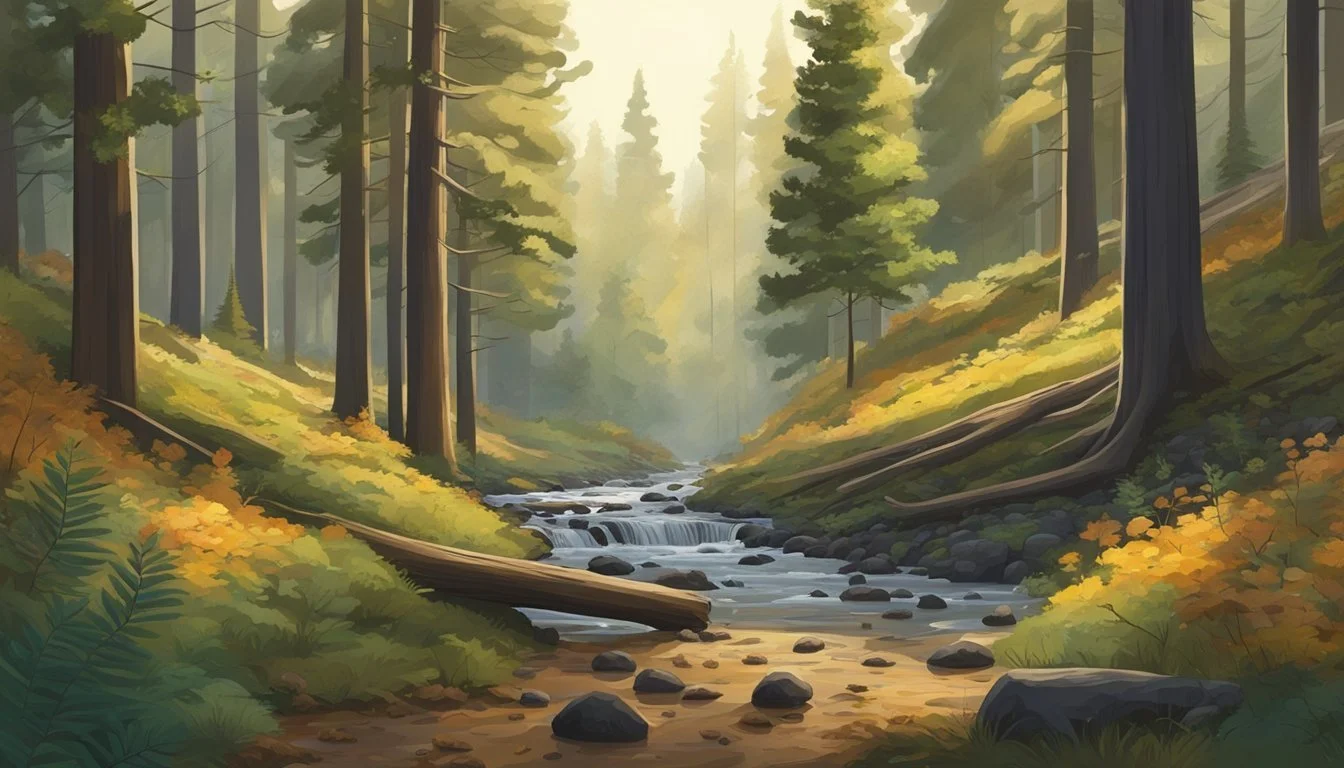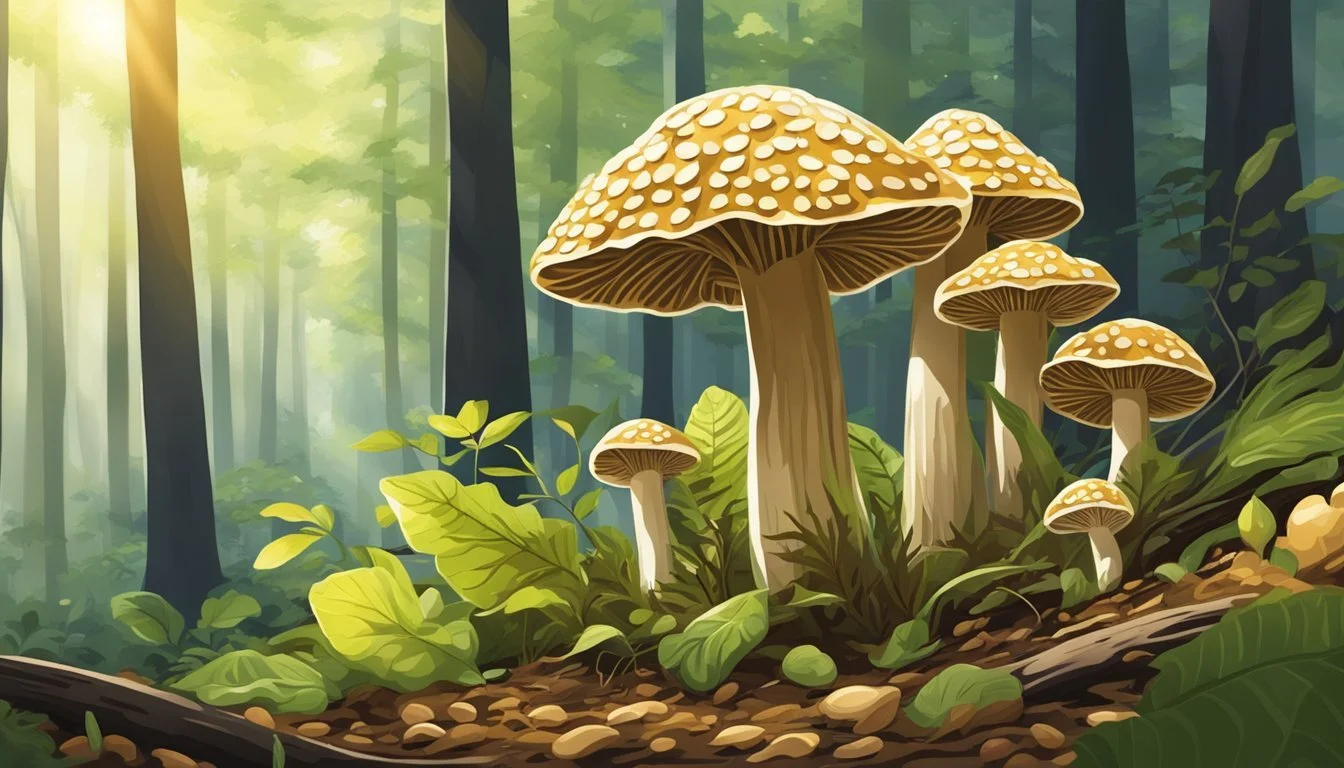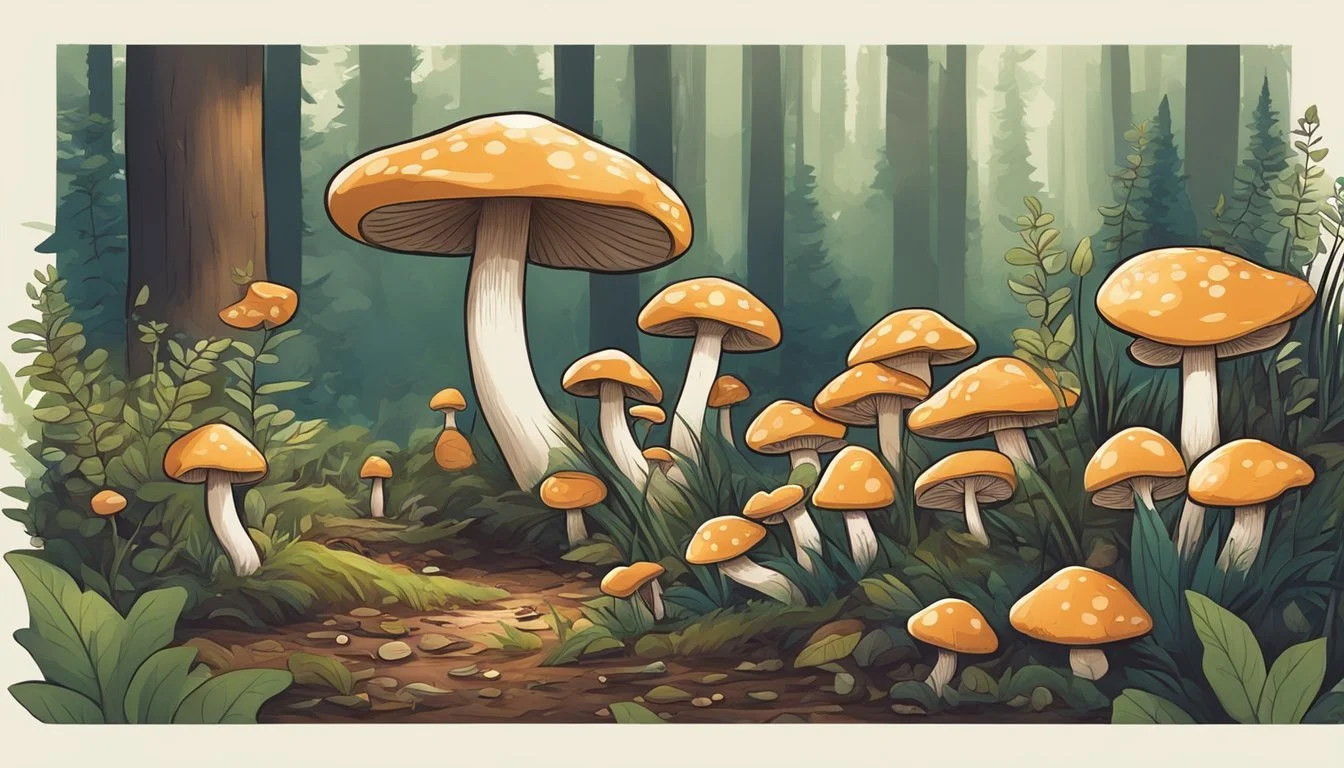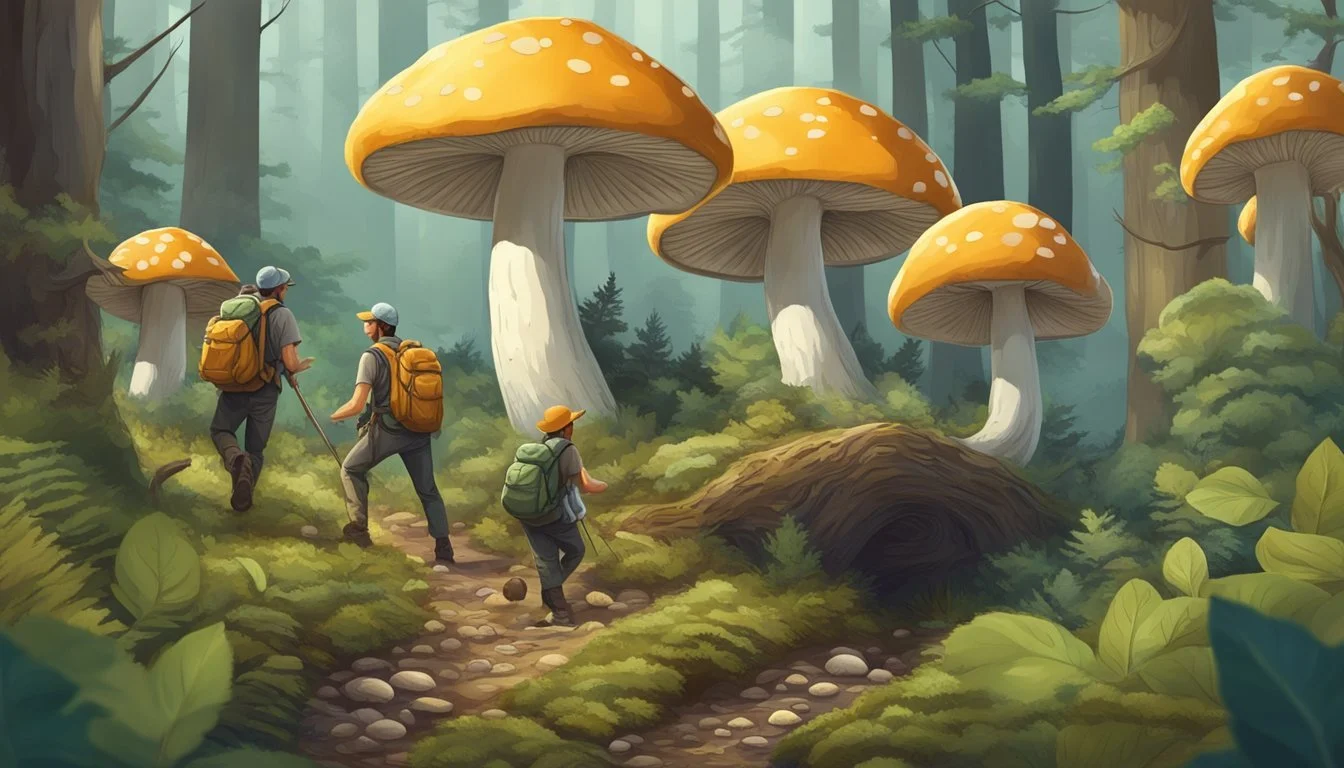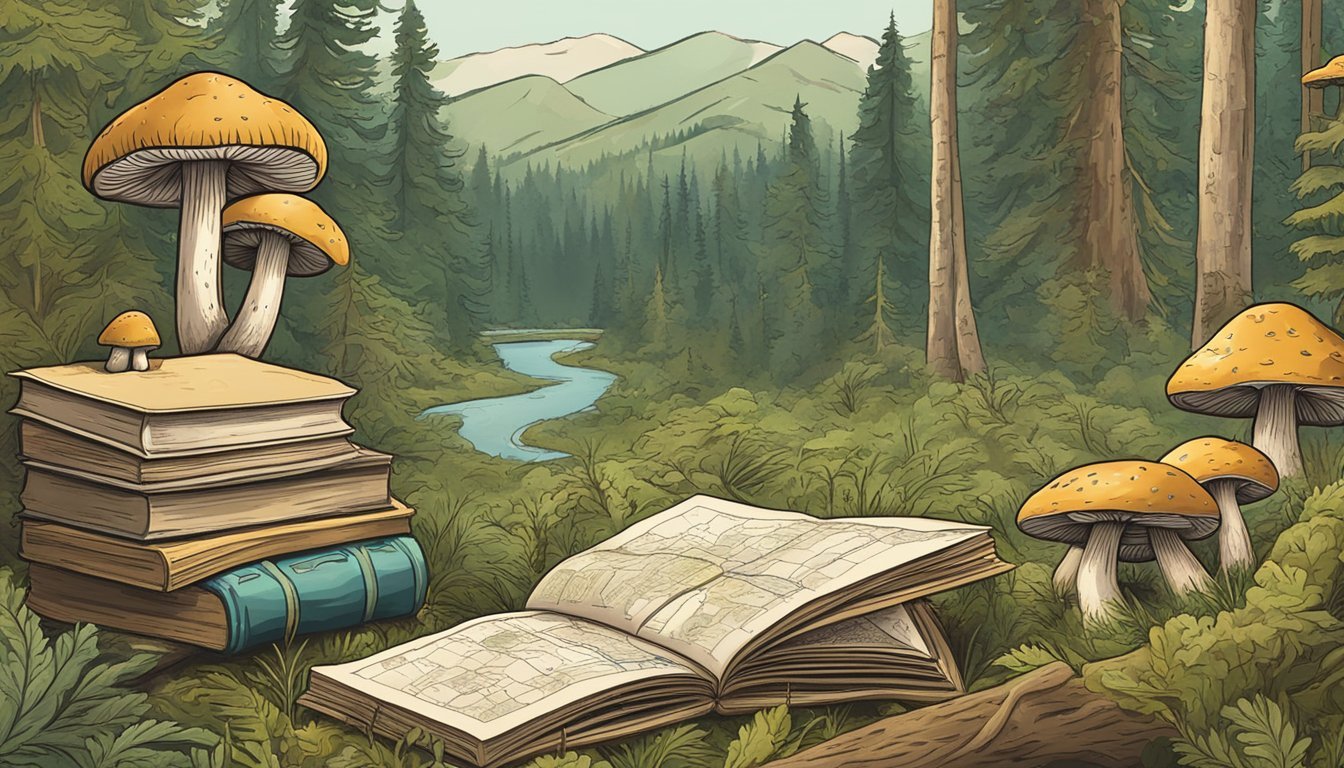Mushroom Hunting Idaho
Your Guide to Foraging the Gem State's Fungi
This Article is Part of Our Guide on Mushroom Hunting for All 50 States
Mushroom hunting in Idaho offers an enriching experience for both amateur and seasoned foragers. The state's diverse habitats, from mountainous pine forests to river valleys, create an ideal environment for a variety of mushrooms to thrive. Among the most sought-after species are the prized morels, known for their distinct taste and unique honeycomb appearance, and the golden chanterelle, celebrated for its delicate flavor and aroma. Idaho's vast public lands provide ample opportunities for mushroom enthusiasts to explore and collect these natural treasures.
When engaging in mushroom hunting in Idaho, foragers must be mindful of the regulations in place to ensure sustainable practices and conservation. The Forest Service typically allows for the collection of up to five gallons of mushrooms per person daily for personal use, reflecting the region's commitment to preserving its fungal populations. As with any form of foraging, it's crucial to positively identify edible mushrooms to avoid consuming toxic species, making local educational resources and field guides invaluable tools for hunters.
Eluding commercial exploitation, mushroom collecting in Idaho is an activity shared by a community of nature lovers, where mushroom clubs often organize forays into the wilderness. These outings are not only a quest for gastronomic delights but also an opportunity for learning and sharing knowledge about the rich mycological ecosystems of Idaho. For residents and visitors alike, mushroom hunting is a way to connect with nature and enjoy some of the state's most scenic landscapes.
Foraging for More Than Just Mushrooms in Idaho
Idaho's rugged wilderness, from the Rocky Mountains to the Snake River Plain, offers a diverse array of wild edibles for the intrepid forager. While mushrooms are a prized find, the Gem State's rich ecosystems provide a bounty of berries, nuts, greens, and roots. Discover the joys of foraging and connect with nature's abundance in Idaho's picturesque landscapes, from the pristine forests of the Sawtooth Range to the rolling hills of the Palouse.
👉 Foraging for Wild Edibles in Idaho
Commonly Found Edible Mushrooms in Idaho
Idaho is home to several edible mushroom species. Some of the most commonly found edible mushrooms in the state include:
Morel (Morchella spp): Commonly found in Idaho, morel mushrooms have a distinctive honeycomb appearance and are prized for their rich, earthy flavor, making them a sought-after culinary delicacy.
Porcini (Boletus edulis): Often found in Idaho, porcini mushrooms have a nutty flavor and are sought after for their meaty texture, making them a popular choice for cooking and foraging.
Meadow Mushroom (Agaricus campestris): Frequently found in Idaho, meadow mushrooms have a mild flavor and are often found in grassy areas, making them a popular choice for mushroom foragers.
Chanterelle (Cantharellus spp): These golden to yellowish-orange mushrooms are often found in wooded areas in Idaho and have a delicate, fruity aroma and a mild, peppery taste, making them a sought-after culinary ingredient.
Coral Mushroom (Ramaria spp): Commonly found in Idaho, coral mushrooms have a distinctive branching and coral-like appearance, and they come in various colors, adding visual interest to the environment.
Blue Oyster (Pleurotus ostreatus columinus): Common on dead and decaying wood.
Bear's Head (Hericium americanum): Grows on living or dead trees.
It is essential to properly identify any mushroom before consuming it, as some species can be poisonous. Beginners should go mushroom hunting with an experienced guide or join a local mycological society to learn how to identify edible mushrooms safely.
Overview of Mushroom Hunting in Idaho
Mushroom hunting in Idaho presents an exciting opportunity for foragers, given the state's diverse ecosystems providing habitats for a variety of mushrooms, including the sought-after Morels.
Legal Framework for Foraging
In Idaho, foraging for mushrooms is permitted, but foragers must adhere to the regulations set by the Idaho Department of Fish and Game, as well as the U.S. Forest Service for federal lands. The state generally allows for personal use foraging without a permit; however, it's vital to respect private property and to forage only in allowable areas. Commercial foragers may require permits, and there are limits on quantities to ensure ecological balance.
Seasonal Considerations
The mushroom hunting season in Idaho typically peaks during the spring and fall. Morels, one of the most prized edible mushrooms, emerge in the spring, especially after a wet season or following wildfires. Autumn also offers a bounty of edible mushrooms but requires knowledge of the specific growing seasons of various species.
Preparing for the Hunt
When embarking on a mushroom hunting adventure in Idaho, one must prioritize safety, possess the right gear, and understand the basics of mushroom identification to ensure success and wellbeing.
Essential Gear and Equipment
A mushroom hunter should equip themselves with a GPS device or maps to navigate the often unpredictable terrain of Idaho's forests. Their gear list should include:
A comfortable and sturdy pair of walking boots for rugged landscapes.
A mesh bag to allow spore dispersal, which contributes to future mushroom growth.
A sharp knife to harvest mushrooms without damaging their underground structures.
Safety and Caution
Hunters must exercise caution by informing someone about their trip and expected return. They should also be prepared for sudden weather changes and carry:
A whistle and a compass for emergencies where technology may fail.
Adequate food, water, and weather-appropriate clothing.
A first-aid kit to address minor injuries promptly.
Mushroom Identification Basics
Proper identification is critical to avoiding harmful species. Hunters should:
Use a reputable field guide specific to Idaho's flora.
Attend local workshops or consult with experienced mushroom hunters to gain knowledge of local mushroom species.
Never consume a mushroom unless its identity and edibility are confirmed beyond doubt.
Ideal Hunting Locations
Mushroom hunting in Idaho offers a variety of locations due to its diverse geography and ecological conditions that are conducive to various mushroom species, particularly morels.
Understanding Idaho's Geography
Idaho's terrain ranges from lush forests to mountainous regions, each providing a habitat for different types of mushrooms. The northern forests near McCall are known for their damp environments, ideal for mushroom varieties to thrive. In contrast, the Sawtooth area presents a more rugged landscape, where hunters can still find mushrooms in specific regions that offer the right conditions with shaded woods and adequate moisture.
Burned Areas and Wildfires
Burned areas, particularly those from recent wildfires, are unexpectedly fertile grounds for morels—the nutrient-rich soil and the absence of a dense tree canopy that allows sunlight to penetrate creates an ideal environment for these mushrooms. For example, the aftermath of forest fires in regions like the Salmon-Challis National Forest can be a promising location for morel hunters in the following spring season.
National Forests and Public Lands
Idaho boasts an extensive network of National Forests and Public Lands where mushroom hunting is permitted, often requiring a permit for larger hauls. Payette National Forest offers a vast landscape of potential hunting spots, while areas around Boise provide accessible locations for urban dwellers. Hunters should always confirm regulations with local ranger districts before harvesting mushrooms on public lands to ensure sustainability and compliance with local laws.
Key Public Lands for Mushroom Hunting Notable Characteristics McCall Damp, mushroom-friendly environment Sawtooth Rugged terrain with shaded and moist areas Salmon-Challis National Forest Rejuvenating burned areas ideal for morels Payette National Forest Vast hunting grounds with permit requirements Boise Accessible spots near urban centers
Hunters are encouraged to respect the land, practice ethical foraging, and verify their finds to avoid picking toxic species.
Best Times for Hunting Morels
The best times for hunting morels in Idaho hinge on specific seasonal and environmental conditions. Morel mushrooms thrive in the spring and post-wildfire environments, with particular weather patterns significantly influencing their emergence.
Spring and Post-Wildfire Season
Spring: In Idaho, morel mushrooms primarily appear in the springtime. Hunters can expect to start seeing these fungi from late April through May. Due to Idaho’s varying elevations and environments, the season extends, with sightings possible into early-mid June and at higher elevations, even through July-August.
Post-Wildfire: Morels have a unique relationship with wildfire-affected areas. They often grow in abundance the following spring after a fire, as the heat from the wildfire helps to break down organic matter, creating a fertile ground for morels.
Weather and Climate Effects
Temperatures: Ideal temperatures for morel hunting are generally after the last frost when daytime temperatures are between 60-70°F and the nighttime temperatures stay above 40°F.
Moisture: Adequate rainfall is crucial as it helps maintain the necessary soil moisture levels. Warm weather following spring or early summer rains creates optimal conditions for morels to flourish.
Timing Morel Emergence
Morel mushrooms follow a somewhat predictable growth pattern tied to the seasonal weather conditions. However, they do not have an exact timetable.
Spring Conditions: The emergence of morels is usually observed when the soil temperatures reach about 45-50°F.
Weather Conditions: Hunters should watch for a pattern of warm days coupled with rain, followed by a return to warm, sunny weather to time the best foraging opportunities.
By considering these specific factors, morel hunters can increase their chances of successful foraging in Idaho’s diverse landscapes.
Harvesting Techniques and Ethics
When collecting mushrooms in Idaho, enthusiasts must adhere to sustainable practices, respect personal and commercial permit requirements, and properly handle and transport their findings to ensure both the protection of natural resources and compliance with local regulations.
Sustainable Harvesting Practices
It is crucial to harvest mushrooms in a way that minimizes impact on their natural environment. Mushroom hunters should:
Only pick mushrooms larger than their thumb, allowing smaller specimens to grow.
Harvest sparingly, leaving enough mushrooms behind for others and for natural propagation.
Use a knife to cut mushrooms, protecting the mycelium beneath the soil.
Personal vs. Commercial Permits
There are distinct regulations for personal and commercial harvesting of mushrooms guided by agencies like the Bureau of Land Management and the U.S. Forest Service. For personal use, individuals are typically allowed to gather a certain amount of mushrooms, such as up to 5 gallons per person per day in areas like the Boise National Forest. Commercial harvesting, however, requires a Commercial Mushroom Permit and adheres to stricter guidelines regarding quantity and sales to prevent overharvesting and ensure sustainability.
Handling and Transport
Proper handling and transportation are essential for maintaining the quality of harvested mushrooms and adhering to the law. Harvesters should:
Carry mushrooms in woven baskets or mesh bags, which facilitates spore dispersal for future growth.
Avoid compacting mushrooms in a way that damages their structure.
Ensure mushrooms are for non-commercial purposes unless a commercial permit is held.
Transport no more than the legal possession limit (e.g., 10 gallons per person per day) to avoid penalties.
Adhering to these guidelines helps mushroom hunters to enjoy their pastime responsibly, respecting both the environment and the law.
Mushroom Ecology and Growth Factors
Mushroom hunting in Idaho is deeply influenced by specific environmental factors that determine where and when mushrooms grow. Recognizing these factors is crucial for successful foraging.
Soil and Ecosystem Influence
Mushrooms thrive in different soil types depending on the species. Morels, for instance, favor soil with a particular pH level, nutrient composition, and symbiotic relationship with certain trees. Soil temperature and moisture content vary greatly with altitude and aspect—the direction a slope faces—which in turn affects the mycelium's ability to fruit. They generally prefer damp, well-drained soils enriched with organic matter.
Understanding Morel Life Cycle
Morels produce spores in spring, which disperse into the environment to potentially form new colonies. The lifecycle of morels is complex and intimately tied to their ecosystem. To fruit, morels require specific environmental conditions, with soil temperature being a critical trigger. When conditions are ideal—warm enough and sufficiently moist—they emerge, often annually and sometimes in great abundance in areas where they have appeared before.
Effects of Forest Fires
Wildfires and forest fires can have a profound impact on morel growth. Burn sites offer a unique opportunity for morels to flourish the following spring, as fires can release nutrients into the soil and alter the landscape in a way that is conducive to morel growth. However, these areas also require an understanding of safety considerations when foraging. Post-fire environments can change quickly, and it's important to be watchful of risks such as falling trees and unstable ground.
Culinary Aspects of Mushrooms
Exploring the culinary aspects of mushrooms reveals their significant role in cuisine, particularly due to their unique flavors and nutritional benefits, which are celebrated by chefs and food enthusiasts alike.
Cooking and Recipes
Morel mushrooms are highly prized for their rich, earthy flavor and are a favorite among Idaho's mushroom enthusiasts. They can be prepared in various ways, each method accentuating their taste and texture. Chef Gary Kucy, renowned for his mushroom dishes (What Wine Pairs Perfectly with Mushroom Dishes), often suggests sautéing morels lightly to maintain their delicate texture. Below is a simple table outlining common preparation methods for edible mushrooms:
Preparation Method Description Sautéing Enhances their natural flavor with minimal ingredients. Grilling Imparts a smoky character ideal for robust mushroom varieties. Baking Concentrates flavors and tenderizes the mushroom.
Foodies appreciate the versatility of edible mushrooms in recipes, with morels often featured in gourmet dishes such as risottos, pastas, and as accompaniments to meats.
Nutritional Value and Taste Profile
Edible mushrooms like morels are not only savored for their taste but also for their nutritional profile. Morels and other edible mushrooms offer a low-calorie content and are a good source of protein, fiber, and vitamins such as vitamin D. Their taste profile varies from mild to a pronounced earthy flavor, which is a sought-after characteristic that complements a variety of dishes.
Morels, especially, have a unique honeycomb-like cap and when cooked, provide a meaty texture with a nuanced, woodsy taste. This makes them a popular choice for both chefs and foodies, who may use morels to elevate the flavor profile of their culinary creations.
Advanced Mushroom Hunting Strategies
Skilled mushroom hunters often employ sophisticated strategies to enhance their foraging success in Idaho. The use of local insights and the ability to adeptly navigate remote terrains are pivotal to this pursuit.
Utilizing Local Knowledge and Resources
Expert hunters know the value of local knowledge in morel hunting. They typically consult Mushroom Maps to identify promising locations. These maps, often procured from reliable resources such as local foraging communities or specialist websites, provide insights into where morels have been found historically. Hunters also take note of ecological indicators such as the presence of trillium flowers, as these plants often share habitats with morel mushrooms.
Local Resources:
Mushroom Maps: For pinpointing potential hotspots.
Community Knowledge: Insights from local foragers.
Ecological Indicators: Observation of companion flora like trilliums.
Navigating Remote Areas
When accessing remote mushroom picking territories, hunters come prepared with GPS devices to ensure they can find their way in and out of these secluded spots. They are also aware that morels often grow at higher elevations in Idaho, especially in areas recovering from forest fires. Safely reaching and traversing these regions can be challenging, so mushroom hunters often plan their routes meticulously. They ensure they have permission for access to private lands and check public land regulations to comply with local foraging laws.
Navigation Tools:
GPS: For accurate positioning and wayfinding.
Topographic Maps: To assess terrain and plan routes to higher elevations.
Land Access Permissions: Confirmed before setting out to ensure legal compliance.
By combining local knowledge, proper resources, and adept navigation skills, mushroom hunters can elevate their foraging experience and success rates in the wilds of Idaho.
Common Challenges and Solutions
Mushroom hunting in Idaho presents unique challenges ranging from navigating natural hazards to differentiating between edible and toxic varieties. The key is preparation and knowledge, with a focus on safety and conservation.
Dealing with Pests and Predators
Mushroom hunters may encounter various pests such as insects or the presence of animal droppings that can contaminate mushrooms. To minimize pest interference:
Wear protective clothing such as long sleeves and pants to deter bugs.
Inspect mushrooms closely for signs of insects or poop, and clean them thoroughly.
Predators, including bears and snakes, are sometimes a concern in Idaho's wilderness. Hunters should make noise to announce their presence and be aware of their surroundings.
Identifying Poisonous Varieties
A primary concern is mistaking toxic mushrooms for edible ones. The false morel is a prime example of a poisonous lookalike that can be confused with edible morels. When identifying mushrooms:
Utilize a reliable mushroom identification guide that covers local species.
Take a mushroom hunting class or go with an experienced guide when starting out.
Mushroom identification involves checking several features:
Feature Edible Morel Poisonous False Morel Cap Shape Honeycomb-like with pits Irregular with wavy lobes Cap Attachment Attached directly to the stem Typically hangs freely from the stem Interior Hollow when cut longitudinally Chambered or cottony
Overcoming Environmental Obstacles
Idaho's mixed conifer forests offer great environments for mushrooms but also introduce challenges like difficult terrain and varying weather. To navigate these:
Plan trips during favorable weather, avoiding post-burn areas that can be unstable.
Stay on trails as much as possible to prevent getting lost.
Caution is essential when dealing with wild edibles and the hazards of the environment. Hunters should always be prepared for sudden changes in weather and familiarize themselves with the terrain prior to setting out.
Local Insights and Expert Interviews
In this section, we explore the rich experiences and valuable advice shared by seasoned mushroom hunters of Idaho, highlighting their journeys and sharing tips that cater to both novice foragers and experienced gatherers.
Stories from the Field
Mushroom pickers across Idaho have tales that capture the essence of adventure and the joys of the harvest. In Ketchum, foragers recount early morning hikes through dense forests, guided by the soft sounds of nature and the anticipation of discovery. They tell of stumbling upon camps previously used by fellow naturalists, creating a sense of camaraderie even in absence. Many describe the exhilaration of finding elusive morels, their brains delighted by the distinctive honeycombed, hollow caps, a treasure trove nestled among the pine needles.
Advice from Experienced Foragers
Experienced mushroom hunters emphasize the importance of safety and education in the practice. Idaho Statesman interviews reveal that expert foragers often stress the critical measure of positively identifying mushrooms before consumption, as there are varieties that are harmful when misidentified. They advise beginners to join experienced mushroom hunters or attend local mycology club outings, benefitting from hands-on learning. Novice foragers are encouraged to hone their identification skills through the following points:
Texture: Morels are wrinkled with a honeycomb appearance, distinct from smooth or differently patterned mushrooms.
Shape: Morels have a characteristic conical shape, unlike toxic look-alikes that might be more rounded or irregular.
Habitat: They're typically found in areas with the presence of ash, elm, and poplar trees, especially after a fire enhances the soil's nutrient content.
Boldly stepping into the Idaho wilderness to hunt for mushrooms is both a fulfilling hobby and a serious endeavor, where knowledge and attention to safety are as important as the adventure itself.
Appendix: Resources and Further Reading
For those interested in mushroom hunting in Idaho, several resources are invaluable for a successful foraging experience. Mushroom hunters should familiarize themselves with the following:
Maps: They can provide insights into ideal morel habitats which often include damp areas near rivers, streams, and on North-facing slopes.
Type Description Topographical Helpful for understanding terrain. Forest Service Indicate public lands and regulations
Resources: Consult the Idaho Mushroom Guide or Morel Hunting 101 from the Idaho Conservation League for identification tips and ecological insights.
Game Trails: These are often indicators of mushroom-rich environments, as morels tend to grow in areas of soil disturbance.
Regulations: Always check for the latest guidelines on the Boise National Forest website to ensure compliance with non-commercial picking and other legalities related to public lands.
Interior: For the adventurous who trek into the interior regions, preparedness is key. This includes navigating remote public lands and being aware of the ecology of the North Fork region, where morels are plentiful post wildfire seasons.
Public Lands: They are open to foraging but come with stipulations to protect these natural resources. Comprehend the permissible quantities and necessary permits.
Before embarking on a mushroom hunting journey in Idaho, mushroom foragers are encouraged to equip themselves with knowledge from these resources to promote both a successful and sustainable practice.



